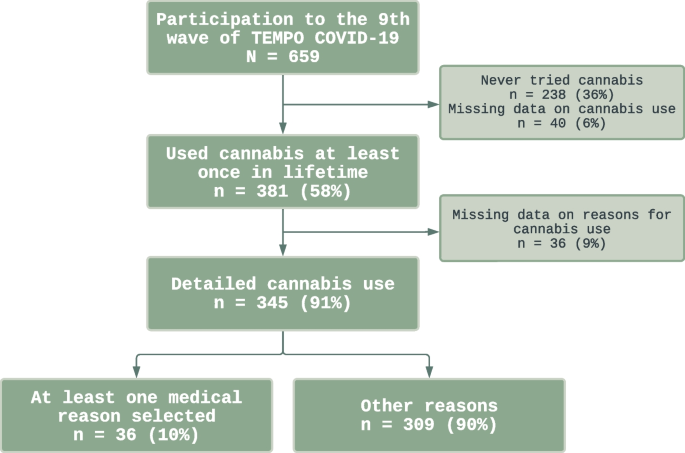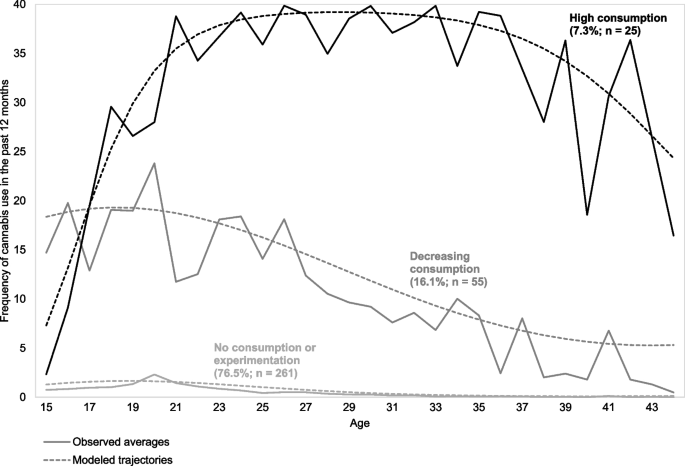Design and setting of the study
The TEMPO (Trajectoires EpidéMiologiques en POpulation) study was set up in 2009 among French adults aged 22 to 35 years who were previously followed in 1991 and 1999 as part of a study on children’s psychological problems (Mary-Krause et al. 2021), and whose parents had participated in the GAZEL cohort (Goldberg et al. 2015). In 2009, participants were interviewed about their mental health and psychoactive substance use, including cannabis use. Subsequent interviews took place in 2011, 2015, 2018, and nine times in 2020 and 2021 in the context of the COVID-19 pandemic (Fig. 1).
Data for this study were collected in the final wave of TEMPO COVID-19, spanning from December 2020 to May 2021, during which detailed information regarding cannabis use and associated reasons were reported for the first time. The questionnaire was completed by 659 TEMPO cohort participants, among whom 381 reported having ever used cannabis, and 345 answered questions about reasons and forms of cannabis use (Fig. 2).
Measures
All measures of cannabis use were self-reported. History of cannabis use and childhood characteristics data were collected from TEMPO cohort questionnaires completed between 2009 and 2018. GAZEL cohort data were used to describe parental characteristics.
Outcome: use of cannabis for self-medication
The use of cannabis for self-medication was defined based on the questions “Why do you use cannabis?” and “In what form do you use cannabis?”. These questions were posed during the last wave of the study, which took place from December 2020 to May 2021. Based on the scientific literature (Haug et al. 2017; Reinarman et al. 2011; Ogborne et al. 2000), 12 reasons and four forms were selected to define use of cannabis for mental or physical health reasons (Additional file 1). Thus, individuals who selected at least one of these items were considered to be using cannabis for self-medication purposes, even if they also had so-called recreational use (“cannabis use for self-medication” vs. “cannabis use for other reasons”).
The medical reason “to get asleep” is missing in the list of proposed reasons, even though it is a frequent reason (Azcarate et al. 2020; Kvamme et al. 2021). However, respondents had the option to add an “other” response at the end of the list and specify the modality. Out of the 29 individuals who used this option, only four mentioned sleep, one of them being already included in the medical cannabis category. To avoid biasing the results with potentially heterogeneous responses, we did not include these subjects in the main analysis. Nevertheless, we conducted a sensitivity analysis including this reason.
Another sensitivity analysis was performed with a second definition of self-medication with cannabis, including additional items that could be related to mental or physical health, particularly focusing on the depressive state or sadness (Additional file 1), following the results of the qualitative study (Rezag Bara et al. 2023).
Potentially associated factors
Factors associated with medical cannabis use, as described in the literature, such as sociodemographic characteristics (Rotermann and Pagé 2018), cannabis use (Rotermann and Pagé 2018; Woodruff and Shillington 2016; Lin et al. 2016), mental or physical health (Rotermann and Pagé 2018; Lin et al. 2016), and the use of psychoactive substances (Lin et al. 2016), as well as other potentially associated factors with cannabis use such as negative events during childhood (Rezag Bara et al. 2023) and parental characteristics (Boden et al. 2020), were studied in the analyses.
Sociodemographic characteristics
Sex (“female”; “male”), age (continuous), marital status (“married, in civil union, in relationship”; “single, divorced, widowed”), and having children (“no”; “yes”) were included in the analysis. The socioeconomic position of individuals was determined by combining educational level (“ > bachelor’s degree”; “ ≤ bachelor’s degree”), employment category (“executive, intermediate profession, craftsman, merchant, company manager”; “employee, worker”), type of contract (“permanent or civil servant”; “fixed-term contract, internship, volunteer, apprentice, subsidized contract, or undeclared work”), and main activity prior to lockdown (“employed or student”; “unemployed”). Each of these variables was coded as 0 or 1, summed, and dichotomized by the lowest quartile (“intermediate or high”; “lower”) (Aljandaleh et al. 2020; Redonnet et al. 2012).
Cannabis use
Lifetime, past year, and past month cannabis use frequencies were asked to determine current or former use (Spilka et al. 2018). The frequency of cannabis use during the year was also asked in 1999, 2009, 2011, 2015, and 2018. This information allowed us, using the Group-Based Trajectory Modeling (GBTM) method (Nagin and Odgers 2010), to determine longitudinal trajectories of cannabis use from adolescence to adulthood among participants who completed at least one study questionnaire. Following recommendations to choose the number of trajectories and polynomial orders (Jones et al. 2001), three trajectories were determined, and each participant was assigned to a trajectory (“experimentation”; “decreasing consumption”; “high consumption”) (Fig. 3). The Cannabis Abuse Screening Test (CAST) was used to identify a high risk of problematic cannabis use (“no”; “yes”) (Legleye et al. 2007). Participants were asked about the age of cannabis initiation in each wave since 1999, the earliest information available was used. The variable was then recoded into 2 categories (“late initiation”; “early initiation”) considering a cut-off at 16 or lower (Hayatbakhsh et al. 2013; Melchior et al. 2017). Participants were asked if they used cannabis alone (“no”; “yes”).
Mental health
Participants’ mental health disorders, including anxiety, depression and internalizing symptoms, were determined using the standardized DSM-oriented Adult Self-Report (ASR) scale (Achenbach 2015). Following DSM-V criteria, all responses were summed, and the score was then standardized with a mean of 50 and a standard deviation of 10 (T score), and then dichotomized by the 85th percentile (“no”; “yes”).
Physical health
Medical conditions were self-reported using the following question: “Have you ever been diagnosed by a doctor with any of the following health problems?”. Individuals could choose from a list of 22 pathologies (“no”; “yes”): accidental polytrauma, arthritis, asthma, cancer, cardiovascular disease (including heart murmur, …), chronic digestive disease (ulcer, …), cranial trauma, Crohn’s disease or other inflammatory bowel disease, diabetes, endometriosis, epilepsy, high blood pressure, insomnia, migraine, multiple sclerosis, musculoskeletal disorders (lumbago, sciatica, tendinitis, …), nervous breakdown, overweight or obesity, post-traumatic stress disorder, psychiatric disorders, and rheumatoid arthritis.
Use of psychoactive substances
Two statements have been used for smoking status (“non-smoker”; “regular, occasional or ex-smoker”). Initiation of tobacco consumption was considered early if it occurred before the age of 14 years old (Clergue-Duval et al. 2019; Breslau and Peterson 1996). Participants’ alcohol consumption in the past 12 months was defined using four categories: “Never, once a month or less”, “2 to 4 times a month”, “2 to 3 times a week”, and “4 times a week or more”. The use of 7 other illicit drugs (i.e. ecstasy, hallucinogens, stimulants, cocaine, non-prescription drugs, heroin, or solvents) was asked and grouped into a variable corresponding to lifetime experimentation with at least one of them (“no, never”; “yes, at least once”).
Negative events during childhood
Events before the age of 15 included repeating a grade (“no”; “yes”) and violence during childhood (“no”; “yes”). This variable was defined using three retrospective questions about events experienced during childhood, addressed in the 2011 TEMPO wave: “Have you witnessed serious arguments or violent behavior between your parents?”, “Has anyone tried to denigrate, devalue, or make fun of you in an insistent, hurtful way (e.g., at school)?”, and “Have you suffered from a serious lack of affection?”.
Parental characteristics
Parental smoking was defined by the highest level of smoking of either parent: non-smoker, former-smoker, and smoker. This information was obtained directly from one parent in the GAZEL study (1989–2015) and from the other parent in the TEMPO study (2009 or 2011), and the highest risk category was retained. The level of parental alcohol use (“non-unhealthy alcohol use”; “unhealthy alcohol use”), parental divorce or separation before the participant’s 17th birthday (“no”; “yes”), and parental depression (“no”; “yes”) were reported by parents in the GAZEL study (1989–2015).
Statistical analyses
Participants’ characteristics were described according to cannabis use: “cannabis use for self-medication” vs. “cannabis use for other reasons”. Differences between the two groups were tested using Pearson’s Chi-squared test, Fisher’s exact test, or Wilcoxon rank sum test.
To determine factors associated with the use of cannabis for self-medication, we used logistic regression modelling. All factors found to be associated with cannabis use for self-medication in the literature were tested in univariate logistic models. Due to the high number of variables with a p-value < 0.2 relative to the total number of subjects (Peduzzi et al. 1996), the penalized regression method “Elastic net” was used to perform a selection of the adjustment variables and to address the issue of multi-collinearity (Zou and Hastie 2005; Tibshirani 1996). We then conducted a sensitivity analysis, including other negative life events.
The number of participants with missing data for each variable of interest varied from four (1.2%), for the cannabis use trajectory, to 14 (4.1%), for smoking status and insomnia. In order to include all participants who reported cannabis use in multivariate model, all covariates were imputed using the Multiple Imputation by Chained Equations (MICE) by Fully Conditional Specification (FCS) (White et al. 2011; Bodner 2008), using 20 datasets (Graham et al. 2007).
Multivariate logistic regression was then used to identify associated factors, and one sensitivity analyse was carried out by expanding the definition of cannabis use for self-medication. Interactions between selected variables were tested.
Data processing and analyses were performed using SAS® 9.4 and R 4.1.0 software (R Core Team 2020) (packages dplyr (Hadley et al. 2021), glmnet (Jerome et al. 2010), mice (van Buuren and Groothuis-Oudshoorn 2011), gtsummary (Sjoberg et al. 2021)).
Discover more from reviewer4you.com
Subscribe to get the latest posts to your email.






